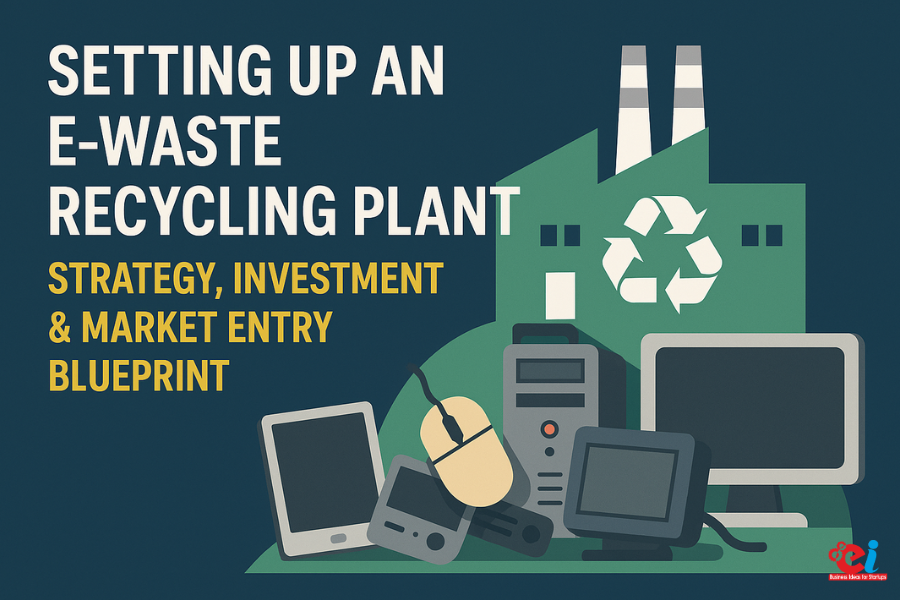With rapid urbanization and digitization, India faces growing challenges of e-waste. In terms of the sheer volume of e-waste produced, India stands at a staggering figure of over 1.1 million metric tonnes, putting it amongst the countries that produce the highest quantity of e-waste. Most of this waste is either disposed of or managed by untrained recycler’s chains without any safety protocols. Although this unrelenting challenge can be termed as an opportunity, an E-Waste Recycling Plant can be a lucrative business and would serve as one of the cornerstones of renewable industrialization.
The aim of this guide is to target potential entrepreneurs and set a profitable and compliant business to aid green startups and MSME by walking them through the process of entering the market through e-waste recycling. We’ll detail everything that leads to investment, revenue generation, business scope location, and technology, ensuring a comprehensive approach.
The Relevance of E-Waste Recycling Plant in India
As technology advances, newer products tend to be more accessible due to an urban lifestyle shift, which increases the disposal rate for laptops, smartphones, TVs, batteries, and printers. With a wide range of e-waste, used electronics contain valuable metals such as gold, copper, and palladium, as well as toxic elements such as lead, cadmium, and mercury. Not recycling these products causes health and environmental harm.
An organized e-waste recycling plant distinguishes reusable metals from other materials, recovers plastics, and disposes of dangerous waste properly. Formal recycling facilities are now prioritized due to the E-Waste (Management) Rules 2022, which fosters legal and scalable ventures that abide by sound environmental practices.
Identifying the Business Model
An entrepreneur is required to thoroughly plan out the business model when setting up an e-waste recycling facility. In broad terms, the plant could specialize in one or more of the following: data destruction, recovering components, dismantling of electronics, refurbishment of working parts, metal separation.
In a basic dismantling unit, workers manually or semi-mechanically remove circuit boards, wires, plastic casings, and batteries from electronic goods. A mid-scale dismantling unit may include shredding, magnetic or eddy current separation, and electrolysis for metal recovery. Larger plants tend to use fully automated setups with more advanced equipment such as X-ray fluorescence (XRF) analyzers and hydrometallurgical extraction technologies.
The selected model impacts land requirements, licensing, required investments, workforce size, and, in some cases, more granular details such as funds estimation.
Related: Green Business Ideas for Startup, Entrepreneurs
Location and Infrastructure Planning
The plant should be located within an industrial zone or a designated waste processing cluster to ease the process of obtaining environmental clearances. This zone also needs to be close enough to urban areas and electronics markets not only for acquiring old devices, but also to reduce overall logistics costs. Road network accessibility, the availability of skilled workers, and essential utilities such as electricity and water can also be determining factors.
The infrastructure layout consists of receiving and sorting areas, dismantling sections, metal recovery areas, plastic reprocessing sections, chemical handling sections if necessary, effluent treatment plant (ETP), storage units, and administrative offices. Clear physical boundaries separating hazardous from non hazardous zones must be maintained throughout to comply with safety and compliance standards.
E-Waste Sourcing and Supply Chain Management
The constant inflow of e-waste is important for sustaining the plant. Partnerships with municipal authorities, bulk consumers (offices, banks, schools), electronics retailers, and scrap dealers ensure a steady supply. A reverse logistics model where customers are incentivized to return used electronics for purchase further strengthens long-term sourcing.
Additionally, some companies establish collection spots for authorized e-waste in adjacent towns or collaborate with OEMs under EPR responsibilities. Informal waste pickers can be formally trained and brought into training and inclusion programs to improve social consequences and comply with labor regulations.
Machinery and Technology Used for E-Waste Processing
Technology selection is a key requirement for the effective operation of an E-Waste Recycling Plant. Basic dismantling equipment comprises workbenches, screwdrivers, wire strippers, and pliers. More advanced processing requires the addition of gold, silver, copper, and rare earth metals recovery units like conveyor belts, shredders, granulators, magnetic separators, eddy current separators, density separation tables, and refining units.
Depending on the scale and the legislative permissions, high-value metals from printed circuit boards (PCBs) can be extracted using hydrometallurgy or pyrometallurgy. These technologies necess the installation of air filtration systems, acid scrubbing units, dust collectors, and measures for reducing noise for compliance with safety and environmental regulations.
Although automation increases throughput and decreases the amount of human contact with hazardous materials, the upfront expense is higher. For smaller units, semi-mechanized workstations provide a more efficient approach.
Legal Restrictions and Their Functionality
An entrepreneur needs permission from the State Pollution Control Board and registration as an authorized E-Waste Recycling Plant with the Central Pollution Control Board to set up an E-Waste Recycling Plant in India. The recycling plant must follow guidelines set forth by the E-Waste Management Rules, 2022 about the processing, transport, storage, and dismantling of recycling appliances.
Moreover, clearances might be required under a combination of the Factories Act, Rules for the Management of Hazardous Waste, and the Environmental Protection Act. Record maintenance of e-waste sourced and recycled, filing annual returns, and safe residue disposal via certified TSDF (Treatment, Storage, and Disposal Facility) operators are mandatory.
If the plant intends to treat the waste for the producers, obtaining primary authorization is essential. This implies contracting with brands and electronics firms to fulfill their recycling responsibilities under Indian legislation.
Human Resource and Training
An E-Waste Recycling Plant requires a blend of skill sets for its operation, from skilled, semi-skilled, to unskilled labor. Specialized technicians who can electronically dissect components and sort materials are crucial. Workers need to be educated on hazardous materials, personal protective equipment (PPE), and emergency procedures.
When hiring a certified environmental engineer or safety officer, internal autopies would be done and pollution control standards would be meticulously adhered to. Staff monitoring new technology, compliance guidelines, and safety procedures also requires continual capacity enhancement activities.
Information About the Markets and Demand Changes
By the end of the decade electricity-driven E-Waste Recycling Plant are likely to see rapid growth on account of rising consumption of electronics, regulation enforcement, and concern for the environment. Urbanized parts of India accumulate increasing amounts of consumer as well as commercial electronics waste which constitutes a tremendous supply base.
As a result of the Make in India initiative, India’s electronic manufacturing industry is growing which in turn increases the domestic need for secondary raw materials such as copper, gold, and rare earth elements. In addition, foreign markets are becoming more interested in purchasing recycled metals from certified Indian processors, which enables the country to serve imported demand while advancing global sustainability goals.
Cost-sensitive customers, SMEs, and schools are increasingly embracing tested and certified refurbished electronics. Entrepreneurs can expand the scope of their products by adopting a hybrid model of recycling and re-manufacturing which will increase profit margins.
Which business to start? How to choose a business idea?
Branding, Marketing, and Outreach
The advertising of the facility should underscore so much of its features and impact initiatives that it would appeal to institutional and EPR brands. Such marketing efforts should also emphasize sustainability measures and certificates that are offered, as the plant should already have these accolades. Partnerships with CSR oriented corporations, NGOs, and academic institutions would help build trust and reputation for the firm thereby increasing supply procurements.
Visibility for the brand could be enhanced by having a website, business pages, attendance in sustainability expos, and hosting informative blogs. Enhanced local participation can result from active engagements through outreach programs that heighten awareness about the facility offered and pickup schemes.
How Niir Project Consultancy Services (NPCS) Supports E-Waste Ventures
NPCS’s support for entrepreneurs starts with fully guiding them on all the steps necessary to set up an E-Waste Recycling Plant. This is particularly targeted at MSMEs who are looking to establish such businesses. Our project reports detail every step including plan outlines, selection of processes and machines, financial planning, risk mitigation strategies, and basic location feasibility studies.
NPCS also helps a long the processes with SPCB applications, setting up EPR systems, and facilitates the necessary permits to construct control mechanisms for pollution. Other forms of aid NPCS offers power documentations for MSME-issued schemes, provide clear approvals from banks, and help clients with connections to the required machinery and training vendors.
NPCS’s consultants emphasize practical approaches under tight deadlines with vast experience on industrial projects. This is blended with comprehensive understanding on evolving policies and green laws on the proposed plant scope of work to guarantee that the facility will meet the built to spec approaches and be self sufficient in the long term.
Conclusion
Building an E-Waste Recycling Plant combines impressive commercial prospects with eco-sensitive impact. Entrepreneurs can create sustainable businesses in India’s sustainability circled with proper technology, an organized sourcing network, compliance to regulations, and aligned policies.
The informal sector comes with challenges, bringing along the transition to organized professional grade recycling. The need for safe and efficient electronically waste disposal increases e-waste as globalization elevates standards. From driven policies and profits to purposeful change, the e-waste recycling industry offers enduring investment opportunities for established and aspiring green-focused MSMEs and investors.

























